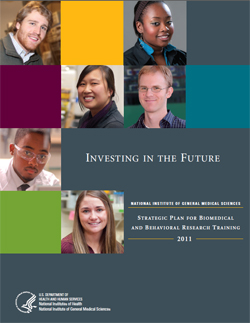NIH’s recent focus on data-intensive and data-driven biomedical research makes this an exciting time for me to be joining NIGMS and leading its Division of Biomedical Technology, Bioinformatics, and Computational Biology (BBCB).
New steps toward harnessing the power of data began well before my arrival and include the NIH Big Data to Knowledge (BD2K) initiative. The overarching aim of this initiative is to enable, by the end of this decade, a “quantum leap” in the ability of the biomedical and behavioral research enterprise to use the growing volume of complex data to produce important insights into biological systems. This is an ambitious goal that requires the collective engagement and expertise of NIH’s many institutes, centers, and offices, including NIGMS, as well as the scientific community.
My colleagues from across NIH have already come together to discuss future solutions that will benefit NIH and the research community as a whole. We recognize that no one-size-fits-all solution will emerge as the “data quantum leap.” Our hope is that by engaging academic, industrial and other biomedical stakeholders, we will impact the volume, variety, velocity, viability and ultimately value of the data that NIH invests in.
To jumpstart this activity, NIH recently issued a new funding opportunity announcement (FOA) for Centers of Excellence for Big Data Computing in the Biomedical Sciences. The purpose is to establish an interactive consortium of centers that will develop approaches, methods and software tools for the aggregation, integration, analysis and visualization of data across NIH-funded research areas. NIH also has issued a request for information on the development of analysis methods and software for big data; responses are due by September 6.
NIGMS and the BBCB staff were actively involved in crafting the new FOA and, more generally, have played a central role in the creation and organization of the BD2K initiative. We will continue to be active partners in this endeavor.
Big data is just one example of the division’s efforts. We foster research in a range of fields, including computational biology, bioinformatics, mathematical and statistical biology, and biomedical technology development. We also support programs that train people in many of these areas.
I’m so happy to be involved in shaping the division’s activities, and I look forward to working together with many of you to continue innovating basic biomedical research.


 Many of the themes in our strategic plan for research training have been echoed by the Biomedical Workforce Working Group of the Advisory Committee to the Director, NIH. Among these is the use of individual development plans (IDPs) to facilitate career development discussions and planning between mentees and mentors. I’m delighted to share some progress on this front.
Many of the themes in our strategic plan for research training have been echoed by the Biomedical Workforce Working Group of the Advisory Committee to the Director, NIH. Among these is the use of individual development plans (IDPs) to facilitate career development discussions and planning between mentees and mentors. I’m delighted to share some progress on this front.